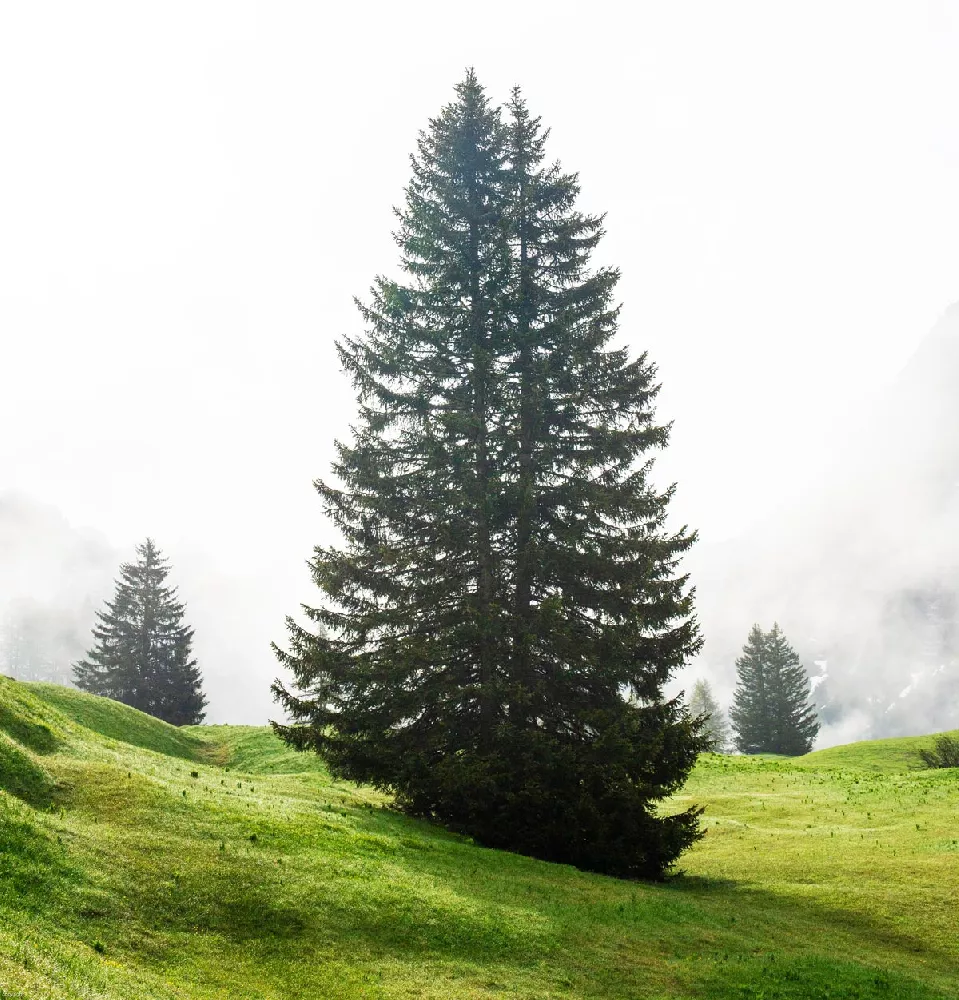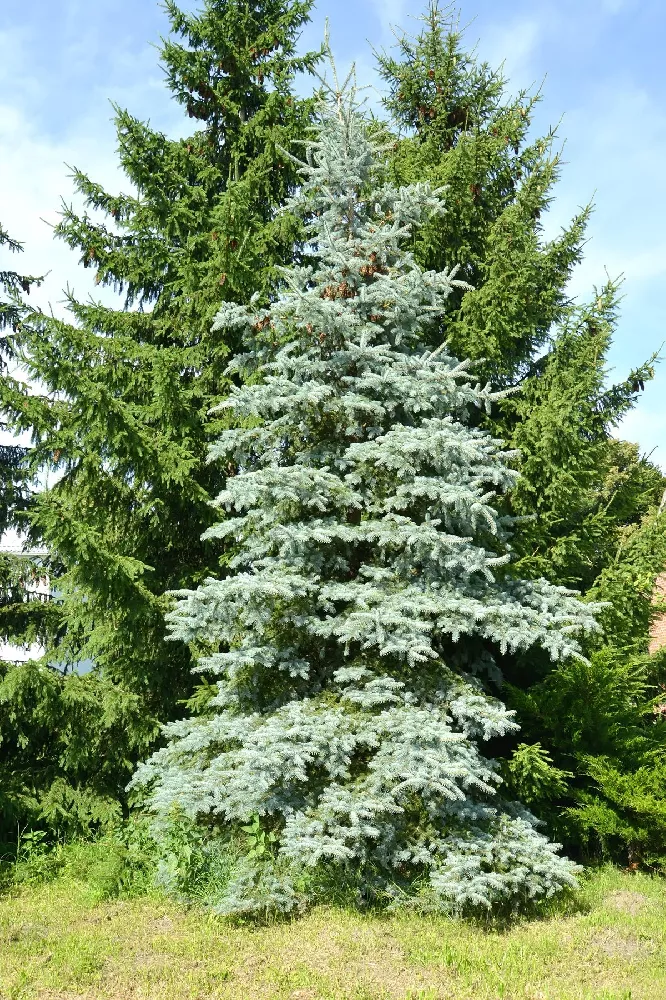- Home >
- Ornamental Plants >
- Weeping Norway Spruce Trees
Weeping Norway Spruce Trees for Sale - Buying & Growing Guide
These unique trees provide an arresting focal point for Asian-inspired gardens or rocky landscapes. With dramatic branches that sweep downward in a waterfall-like flow, they help draw the eye toward other plantings or garden hardscape around the base of the tree. They can be grown as a vertical with staking or allowed to assume a more natural form as a ground cover. The tree also does well growing against a gate or fence. It's adaptable to a wide range of temperatures and soil conditions, and it’s quite pest-resistant, making it an excellent choice for any gardener. Here are some other reasons to love the weeping Norway spruce tree, Picea abies 'Pendula':
- When staked, it maxes out at a reasonable 4-15 feet tall.
- It provides four seasons of interest in the garden.
- This slow grower can also be grown as a patio plant.
Enter your zip code to find nearby stores that may carry this plant.
Plant Care
Sunlight

Although the weeping Norway spruce tree can tolerate some shade, it grows best with at least six hours of sunlight a day.
Watering
New trees need weekly water, but once established, the weeping Norway spruce tree shouldn't need supplemental watering.
Fertilizing

Apply a balanced fertilizer meant for trees and shrubs sparingly in early spring.
Planting and Care
Planting instructions
Site your weeping Norway spruce where it will get at least six hours of sun, at least 6 feet away from driveways and sidewalks, in soil that drains well. Unpot the sapling and tease out any roots that are encircling the root ball. Dig a hole that’s as deep as the root ball and twice as wide.
Place the root ball in the hole so that the top of the root ball is level with the soil grade, and fill in around the roots with a mix of topsoil and well-rotted compost or manure. Tamp down as you go to eliminate air pockets.
If you want your spruce to grow vertically, place several 2-inch by 2-inch wood stakes or metal posts about 8 inches away from the trunk after it’s planted. Attach your tree’s trunk loosely with fabric ties, tight enough to keep the tree upright but loose enough that they won’t rub off any bark. Water your weeping Norway spruce tree thoroughly, and mulch around the trunk with an organic product, such as bark chips, to help conserve moisture.
Watering and nutrients
When young, your weeping Norway spruce tree will need regular watering whenever the top few inches of soil are dry. Monitor the soil for the first two to three years, while the plant is still developing the extensive root system that will provide it with water when it matures. Once your tree is well-established and growing steadily, you can taper back on water unless you’re experiencing drought conditions.
Weeping Norway spruce trees don’t need much additional fertilizer if they are planted in relatively fertile soil. A light dressing in spring with a balanced product designed for landscape trees and shrubs is all your tree needs each year.
Pruning
The weeping Norway spruce tree grows naturally in an attractive shape and needs little shaping. If a branch sticks out at an odd angle, you can cut it back at a node (from which new growth comes) in the spring. Cut out dead, diseased, or damaged limbs whenever you see them. Always use clean pruners that have been sterilized with isopropyl alcohol.
Pests and diseases
Weeping Norway spruce trees are susceptible to several fungal diseases, including cytospora canker and rhizosphaera needlecast. Cytospora will cause yellow-orange spots on the trunk, as well as small raised areas on the bark of the tree. Rhizosphaera, meanwhile, may cause the needles to turn brown and fall off. A copper fungicide is your first option for defense, as is keeping your tree healthy so it can fight off infection. Space trees well away from each other, and avoid overwatering.
Pests include spruce spider mites, which feed on the needles. This causes them to slowly turn brown and die. These tiny insects are difficult to see with the naked eye, and you are more likely to identify them by the webbing they leave at the base of the needles. Bagworms may also prey on spruce needles, leaving behind silken bags filled with eggs. A healthy tree will fight off infestations, or you can use organic insecticides sparingly.
Achieving maximum results
Weeping Norway spruce trees are a landscape artist’s dream, and, if properly sited, can provide a central item of interest in a garden. These slow-growing conifers are prized for their attractive foliage and shape, and if you give them a little extra attention when they are young, they will reward you with years of beauty. Consider shape when you plant your spruce. If you wish it to grow to its potential 15-foot height, you will need to give it sturdy support when it is young. Left to its own devices, the tree’s central trunk may twist and snake along the ground rather than growing tall.
The weeping Norway spruce is also a candidate for the patio garden. It is cold hardy, so it would not need to be brought inside except in the most northern areas, and it should grow naturally to fit its container with adequate water and light applications of a general purpose fertilizer.
FAQs
Is the weeping Norway spruce easy to care for?
Yes, it is. In its early years, it does need weekly waterings, and you will have some occasional pruning to do to shape the tree, but in general, weeping Norway spruce trees are not difficult trees to grow. They have few natural enemies and do not require much intervention once they have reached their prime. If you are growing your spruce in a container, you may have to repot it every other year or so, but even then, it is a tree that is easy to care for.
How is a weeping Norway spruce tree best used in a landscape?
These trees are focal points, and you don't want to hide them in a corner. One option is to include them in rock gardens, where they provide a green and leafy counterpoint to strategically-placed rocks. They can hold their own if planted near a house, but they are probably best used without a lot of fussy floral plantings around them.
Does a weeping Norway spruce need protection in the winter?
The weeping Norway spruce is hardy to USDA zone 3, which means it can handle temperatures down to -30 Fahrenheit. Having said that, it's a good idea to protect young trees that are not well-established if your temps are ranging into the negative numbers or if you are experiencing high winds. You can do so by wrapping the young tree in burlap and securing it with twine or by erecting a burlap fence to shield the tree from prevailing winds.
Compare Similar Products
You can't add more Product Name - Product size to the cart.
OK








